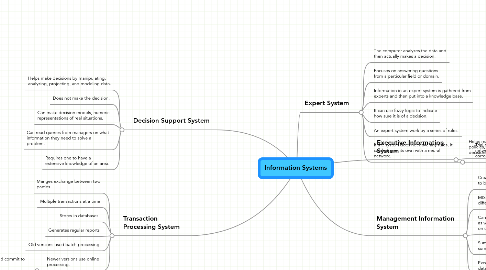Information Systems
by Michael Shepard


1. Decision Support System
1.1. Helps make decisions by manipulating, analyzing, projecting, and modeling data.
1.2. Does not make the decision.
1.3. Can make decision models, numeric representations of real situations.
1.4. Can read queries from managers on what information they need to solve a problem.
1.5. Requires one to have a extensive knowledge of an area.
2. Transaction Processing System
2.1. Manges exchange between two parties
2.2. Multiple transactions at a time
2.3. Stores in databases
2.4. Generates regular reports
2.5. Old versions used batch processing
2.6. Newer versions use online processing.
2.6.1. Uses rollback and commit to prevent errors.
3. Expert System
3.1. The computer analyzes the data and then actually makes a decision.
3.2. Focuses on answering questions from a particular field or domain.
3.3. Information in an expert system is gathered from experts and then put into a knowledge base.
3.4. It can use fuzzy logic to indicate how sure it is of a decision.
3.5. An expert system work by a series of rules.
3.6. If the system does not have any rules, it can learn on its own with a neural network.
3.6.1. Trial and error trains the network as well as human correction.
